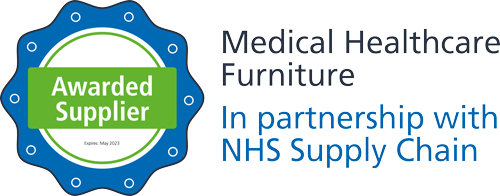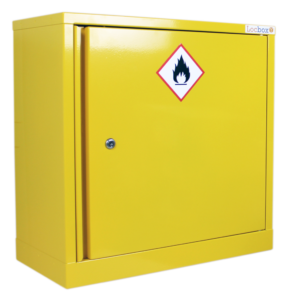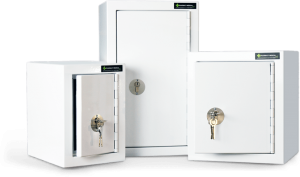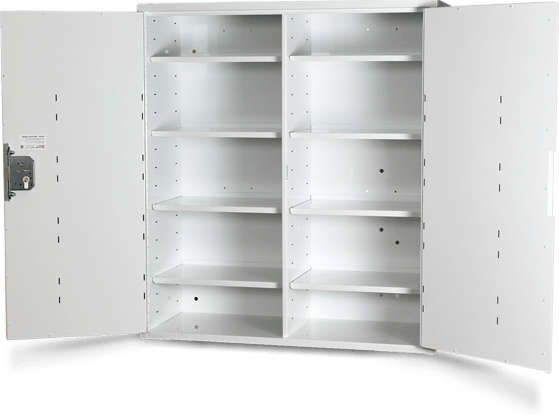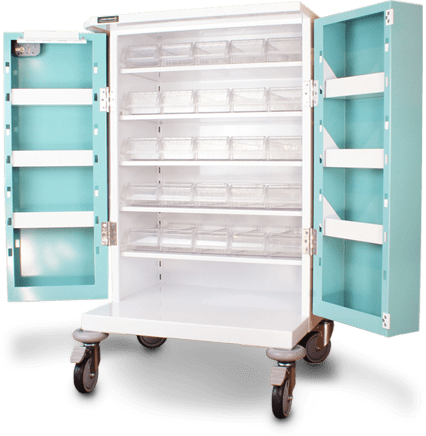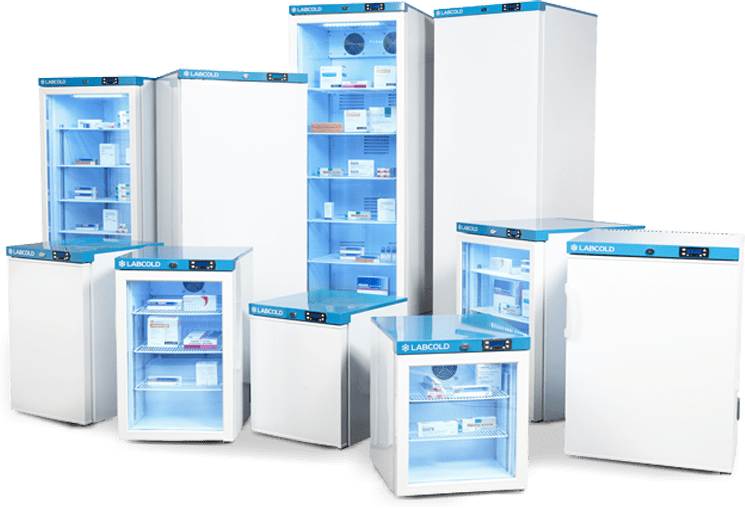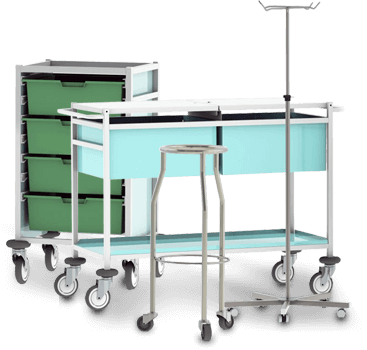How are Controlled Drugs Cabinets made?
Here at PharmacyMedical we manufacture a range of controlled drugs cabinets. Over the years we have built a solid reputation based on high quality products, market leading prices, and next day delivery. As a result, we thought it was time to show you how we do it. Below walk through guide following us at PharmacyMedical manufacturing our controlled drugs cabinets.
Controlled Drugs Cabinets Manufacture
To buy Controlled drugs cabinets from our range please click here.
The controlled drugs cabinets start as flat sheets of steel 2mm thick . The minimum requirement for controlled drug cabinets (BS2881:1989 level one) is 1.5mm thick steel however we like to use the thicker 2mm steel for our Controlled drugs cabinets making them much stronger than others.The metal blanks are guillotined or laser cut to size and material notched out to accommodate the corresponding parts when the cabinet body is assembled. Notches are important, they ensure after the component parts have been bent all the joints are a good tight fit. This good fit helps reduce the heat and filler wire required during welding which speeds up the process and limits weld distortion. To reduce the size of the weld bead we use Tungsten Inert Gas welding as it’s neater & means there is less weld to clean off prior to powder coating process.A Laser cutter shapes the metal to form the door profiles and also incorporates the key holes while removing corners for clearance when bending. The Laser cutters accuracy ensures consistency and uniformity throughout the manufacturing process.
The metal blanks that will later be welded together to form one of our controlled drugs cabinets are then bent to the required shape using a “Press brake”. This process exerts over 100 tonnes of pressure on the metal through a top and bottom “V” shaped tool. This process forms a tight bend in the steel to a pre-set angle. The bent cabinet doors and bodies are passed on to operators where the lock plates and door shelves are welded on.Welding the pre formed component parts to make Controlled Drugs cabinets.
Welders assemble the pre formed parts of the cabinet by applying a small tack weld at various intervals along the joints to tack the parts in position prior to welding. The Controlled Drugs cabinet doors are then offered to the cabinet body to ensure a good fit between the door and the Controlled drugs cabinet body. The Misuse of Drugs (Safe Custody) Regulations 1975 requires a maximum gap of 3mm between the door and the jam, also that anchor plates are placed over the holes through which the cabinet is fixed to the wall or floor. The anchor plates have to be a minimum size and thickness in order to comply with the act. Their purpose is to reinforce the area around the fixing holes to help prevent forced removal of the cabinet.
When the craftsman is completely satisfied with the fit of all the Controlled drugs cabinets’ parts and that the relative items have been installed the cabinet is fully welded, this is another requirement of the Misuse of Drugs (Safe Custody) Regulations is that the cabinet is a fully welded construction.
As mentioned earlier we use a method of welding called TIG (Tungsten inert gas) which gives a very precise and neat weld reducing the need for excessive dressing of the weld reducing the labour time and therefor the untimate cost of the controlled drugs cabinet to the customer.
Powder coating.

Powder coating a controlled drugs cabinet part. Powder coating adds a statically charged powder of paint onto the metal part. This ensures an even coverage that is then bonded to the part by heat in an oven at over 150 deg C. This results in a tough, hygienic finish.
The competed Controlled drugs cabinet parts are transferred to our purpose built powder coating plant adjacent to the fabrication shop where they are degreased and thoroughly cleaned to remove all traces of grease and dirt.
They are then suspended from an overhead conveyor that transports the manufactured cabinets around the powder coating process.
The powder coating process applies powder to the controlled drugs cabinet parts using a special electro static gun. The gun applies up to 100,000 volts of positive static charge to the fine powder particles which are attracted to the negatively charged controlled drugs cabinet parts. The parts are earthed vis the conveyor track contacts so the charged particles remain on the metal until permanently fused into a solid coat in the curing oven. The static charge in the powder forces the particles into the corners and behind any flanges ensuring good coverage of the metal parts.
The curing oven is a long tunnel which the controlled drugs cabinet body assemblies are passed when the powder has been applied. The oven is kept at a constant 215 degrees C & the cabinets need to be kept at that temperature for 12 – 15 minutes which allows the powder to bake forming a solid coating.
On exiting the oven via the conveyor the parts continue along the track cooling as they go round and are then removed to be taken to the assembly area.
Final assembly.

Riveting a controlled drugs cabinet door onto the main body. This ensures a strong, safe and secure fit.
At this point the Controlled drugs cabinets are almost finished.
All parts are re-checked and assembled ensuring they are compliant with both BS2881:1989 level one and Misuse of Drugs (Safe Custody) Regulations 1975.
Doors are riveted to the cabinet body using a compressed air riveting gun.
Controlled drugs cabinet bodies and doors are powder coated separately to ensure a good cover of powder in all areas. The doors are then riveted in place.
Seven lever mortise locks or Euro cylinder locks are bolted to the doors and any pre packed shelves are placed inside the cabinets.
Packaging and warehousing.

We keep all our controlled drugs cabinets in stock. This allows us to offer next day delivery. Please note that stock levels may vary during peak times. This is some of the larger cabinets we have, smaller cabinets are kept elsewhere in the warehouse.
Finished Controlled drugs cabinets are packages in protective foam and boxed for shipping.
We carry good stocks of all our products so can
despatch Controlled Drugs cabinets from our warehouse the next working day.
Visitors are most welcome, please call to arrange a visit. .
Pharmacy Medical produce bespoke purpose-made controlled drugs cabinets to suit specific and unique requirements, please email Pharmacy Medical today. Or telephone 01623 559966 for an extremely competitive quote!


